Maya Rudolph Is Hiding in Plain Sight
- Oops!Something went wrong.Please try again later.
- Oops!Something went wrong.Please try again later.
- Oops!Something went wrong.Please try again later.

There aren’t too many things that terrify Maya Rudolph. The list is basically black widow spiders, stand-up comedy and walking into a roomful of people she doesn’t already know and having to introduce herself.
The first on that list could actually kill her, and the latter two require her to be herself, which is “just so naked and vulnerable,” she says as she forks into a Goop salad on an overcast afternoon this spring. It’s fitting, then, that Rudolph has devoted so much of her existence to becoming other people: a collection of divas on Saturday Night Live, the briefly incontinent bride in Bridesmaids, a hormone monstress on Big Mouth and, soon, a billionaire divorcée on the Apple TV+ comedy Loot.
More from The Hollywood Reporter
Molly Shannon Returns as 'SNL' Beloved Character Jeannie Darcy to Parody Chris Rock Comedy Special
Molly Shannon and Ego Nwodim Lose the Jonas Brothers in 'Saturday Night Live' Promo
The wigs, the voices, they’re all armor, she acknowledges. “Deep down, it’s probably all those years of living with tragedy on my forehead,” she says of losing her mom, famed Black soul singer Minnie Riperton, to breast cancer just two weeks before she turned 7. “And then being asked about it and, ‘Oh, that must have been so hard for you,’ and I don’t want to have that conversation. I don’t want to feel that way. Like, why are we talking about sad things?”
To this day, Rudolph is considered, among her friends, an authority on losing a parent, she says, though she never got to mourn in private, as they would. Her mother’s death, which left her with neither a female role model nor a Black one at home, was every bit a public experience — right down to the Jet magazine cover, for which she, her brother and their white music producer father would pose. The headline that accompanied it: “Minnie’s Family Faces the Future With Her Dreams.”
Inside were photos from her first motherless birthday party, including a shot of young Maya treating her guests to a dance she’d titled The Heart Attack, inspired, she’d said, by the comic stylings of Sanford and Son’s Redd Foxx. “I don’t remember the dance at all, but, like, coining it The Heart Attack? Of course I’d do that,” says Rudolph, who now, at nearly 50, has four children of her own with her longtime partner, director Paul Thomas Anderson.
It was also a way to try to extinguish any lingering sadness, to make everyone around her feel more comfortable — to make herself feel more comfortable. “There were so many factors that made me feel like there wasn’t anyone else like me growing up — because I was mixed, because I didn’t have a mom — and I just wanted to fit in. I just wanted to be normal.” Rudolph stops herself there and backtracks: “But I also didn’t want to be normal.”
***
Long before she was mangling the English language as Donatella Versace or caressing a loaf of bread as Oprah Winfrey, Rudolph was channeling that energy into a video camera in her best friend’s living room. Between renditions of Annie and Fame, the pair would play “talk show.” Her friend was the host, Dinah Shore, whom they’d renamed Dinah Snore, and Rudolph would be her ridiculously confident larger-than-life guest.
“I think the word we’d probably use today would be ‘diva,’ ” she says, seated in the backyard of her residential office, acknowledging that she could just as easily be describing any number of characters she’s released into the world as an adult. “Like, it’s not just a lady, it’s a lady with a feather boa and that feeling of, ‘I’m here and I’m very loud.’ “
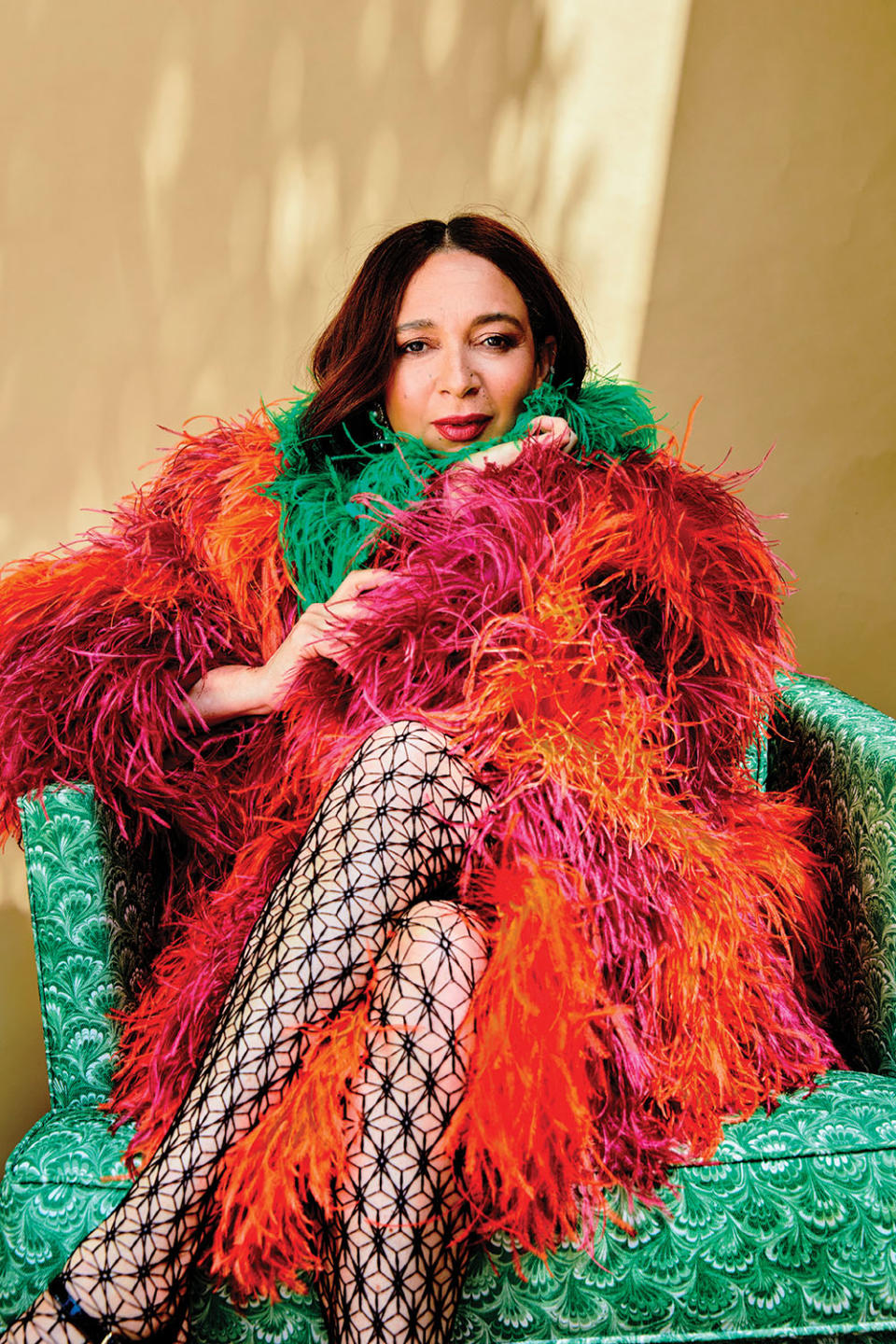
Photographed by Christian Cody
Where the draw to Mae West-style characters comes from has long been a source of fascination for Rudolph, whose everyday energy is considerably lower-key. Part of it, she’s certain, is that she was raised in a house full of men, which meant she spent much of her childhood obsessed with what it was to be a woman. Playdates were often an excuse to rummage through friends’ medicine cabinets to see what exactly womanhood required. What she couldn’t learn through observation, she worked out through performance. If you think about it, she says now, “most of my characters are drag queens because all I wanted was to be a ‘real girl.’ “
It’s not lost on Rudolph that her memories of her mother are larger-than-life too. “The fact is, I saw my mom with a spotlight on her and total command of the stage,” she says, having tagged along to sound checks and tour dates. “She’d have flowers in her hair and a microphone in her hand, and how could that not have a dramatic effect on me?”
For years after, Rudolph would show up to school in her mom’s vintage gowns, which she’d pair with cowboy boots or whatever else she’d thrifted the weekend before. Fashion became as much a form of self-expression as it was another suit of armor. “She was always so inherently cool with her style, never trying too hard, never following others,” says Danielle Renfrew Behrens, a veteran producer and friend since kindergarten who now runs Rudolph and Natasha Lyonne’s production company. In fact, Behrens just assumed Rudolph would go into fashion. And, at a few different points, she did flirt with the idea of launching her own line, though admittedly she’s more interested in the clothes than the business.
Jack Black, who was a few years ahead of Rudolph at Crossroads School in Santa Monica, remembers nothing of her outfits but has a distinct memory of her joining his improv class and immediately knocking him off his game. “I was really enjoying being king of the hill of the theater department, and then here comes Maya, and she was just so funny and gifted and relaxed, and it really made me question whether I should even continue, like, that’s how strong she was,” says Black. “It’s like I was Salieri and she was Mozart, and I was so jealous that it kind of paralyzed me.”
It was Black who took her to her first Groundlings show at 14. Years later, after Rudolph earned her degree from UC Santa Cruz and played with the first of a few bands, she joined the comedy troupe and, as she tells it, found her people. Emily Spivey was among them, and the pair quickly became writing partners. “It was like a portal opened up in Maya’s side and I just plugged into it,” says Spivey, who would later follow Rudolph to SNL. “And it’s funny because we couldn’t have had more different childhoods — she was raised in Los Angeles, and I’m from High Point, North Carolina — but we laughed at all the same things and we love writing these humongous characters and we just fell in love with each other.”
Together, the two have worked on at least a few hundred sketches, not to mention a film (Wine Country), a sitcom (Up All Night), an animated comedy (Bless the Harts) and a variety show (Maya & Marty). Some of their early work can still make Spivey howl, like “Feminist River,” about two feminist college girls who were singing about their periods as one of their boyfriends shouted profanities at them from the audience. When the time came, there was more than enough for a compelling SNL reel, which Spivey’s now husband edited for Rudolph and then overnighted to New York. Somewhere, Spivey still has the FedEx receipt.
But before Rudolph landed her dream job, she dabbled: as a costumer’s assistant, a waitress, a singer and an actress, landing her first real role on City of Angels, a Steven Bochco medical drama for CBS. Rudolph should have been thrilled, but set life wasn’t nearly as intoxicating as the stage. She was, and still is, happiest performing live. Then, in 2000, she landed her meeting with Lorne Michaels. He asked her the million-dollar question: “Why do you think you should work at Saturday Night Live?” Rudolph’s response, which mortifies her to this day: “Because I love wearing wigs.” She was hired anyway.
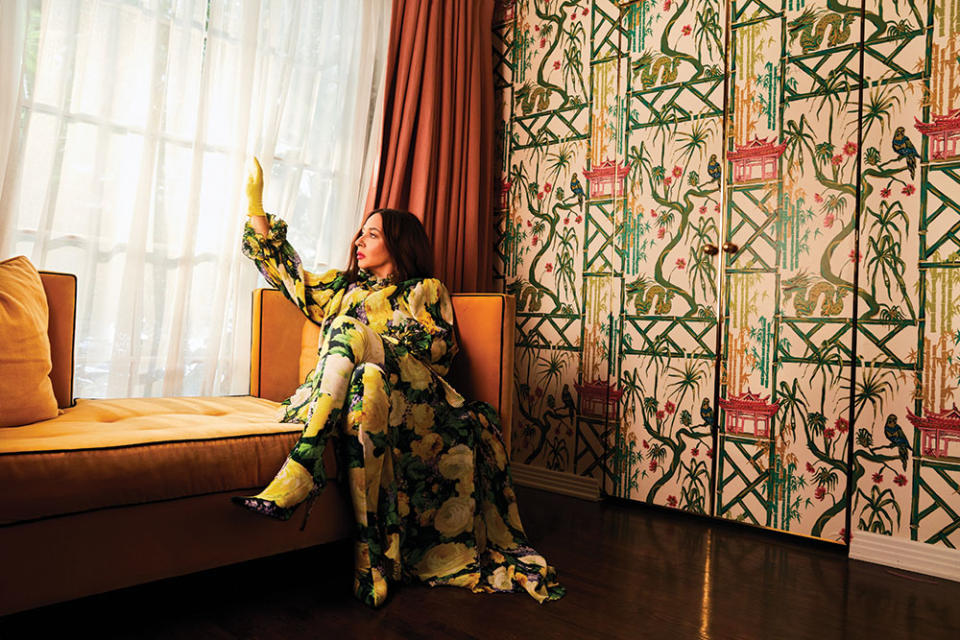
Photographed by Christian Cody
***
Rudolph started at the tail end of SNL‘s 25th season, which was exhilarating for her and unsettling for many of her new colleagues who feared she’d come to replace them. She still remembers asking Chris Parnell, whom she knew from The Groundlings, what, exactly, she was supposed to do. “We just write,” he told her. “Till when?” she asked. “Till, like, 7 or 8 in the morning,” he said, and then all the doors started closing. So Rudolph walked into an office and opened up the Mac SE/30 on the desk. The name of its previous user popped up onscreen: Paul Thomas Anderson.
The filmmaker, who’d broken out with the 1997 drama Boogie Nights, had been at SNL the week before. He was getting ready to make Punch-Drunk Love with former castmember Adam Sandler when Molly Shannon, with whom he had mutual friends, invited him to come see how the show came together. Before Anderson knew it, he was directing a short. Rudolph remembers catching a glimpse of him on show night; he remembers seeing her name listed as a new castmember on a piece of paper. He knew in that moment that his “life had just changed,” he later told SmartLess co-hosts Will Arnett, Jason Bateman and Sean Hayes.
As the story goes, Anderson went back home to Los Angeles, where he watched Rudolph on TV and was bowled over by how talented she was. On his way to London to work on his Sandler dramedy, he made sure to stop briefly in New York to come by the show and meet her. “Then I got to London and thought, ‘Well, something doesn’t feel right,'” he said, “and I just came back to New York [to take her out].” That was 22 years and four children ago. Rudolph says she knew only pieces of that story before she heard Anderson telling it on air, though she plays coy on which pieces.
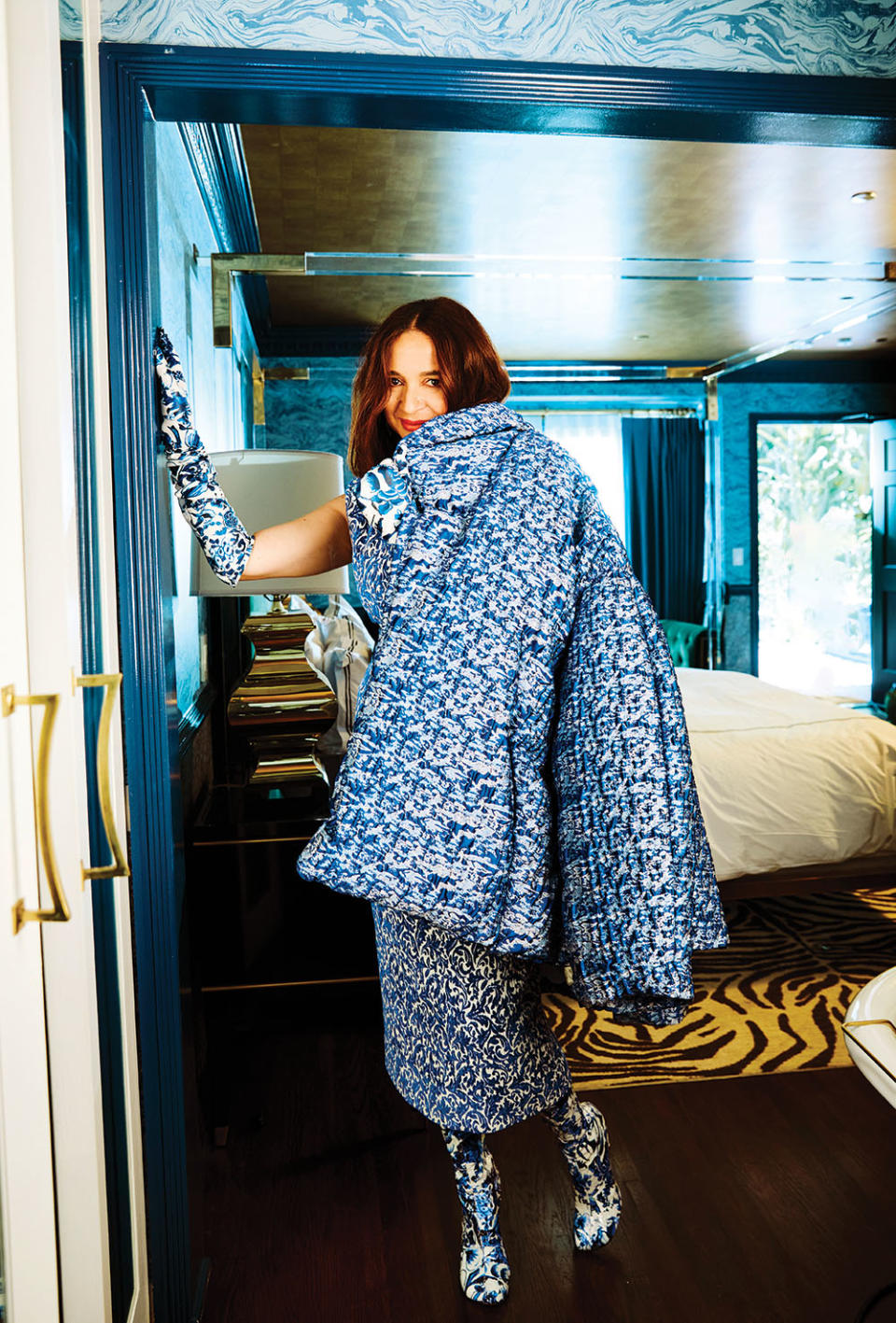
Photographed by Christian Cody
Around the same time, Rudolph found a sisterhood at SNL. Her office, which she shared with Spivey and lined with Cosby Show and The Police posters, became a gathering spot. Amy Poehler, who had the office next door, remembers spending an inordinate amount of time in there. “We needed a place to take refuge and figure ourselves out, and that’s what Maya and Spivey’s office was,” she says. “We’d go in there, smoke cigarettes and stare out at the Empire State Building and talk about how hard our dream job was.”
For Rudolph, it would take time to find her voice at SNL. In fact, she’s often wondered whether she would have been better off had she started at the show a few years later than she did. “I spent so much time telling myself I was weird and not being comfortable with the person I really was,” she says. But by that point, she’d already internalized years of coded messages from those in the industry who told her they didn’t know what to do with her hair or wondered how she treated all the moles on her face. And now, at a job she’d been preparing for all her life, she’d have to come to terms with the fact that she wasn’t wanted for every part, that she’d be relegated to racial roles and that white characters, particularly political ones, would typically go to white castmates.

Will Heath/NBC
In Rudolph’s mind, she could play anyone — white (Liza Minnelli), Black (Beyoncé), Latina (Jennifer Lopez) — and when she was involved in crafting her own material, she very often did. In fact, Poehler still marvels at a Good Times sketch they did that required her friend to play every member of the studio audience. “Maya went into the booth and recorded all of the audience reactions, and because there was a lot of sad and real stuff on that show, there was a lot of, like, ‘Oooohs’ and ‘Ahhhhs’ and ‘Oh nos!’ and, like, ‘You tell ’em, Willona!’ ” says Poehler. “And it was so funny and we used to just play it all the time.”
Michaels isn’t particularly interested in wading into the racial politics of the period; what he remembers is the intense joy that Rudolph brought to every performance, much as Gilda Radner had before her. “There are certain people who are tortured and perform, and that’s the thing that’s fulfilling to them, but with Maya, she just loves doing it,” he says. “She finds the two or three laughs that no one noticed were there, and it’s just magic when she’s onstage. And she’s not going to leave a stage without the audience happier than they were even 20 minutes before.”
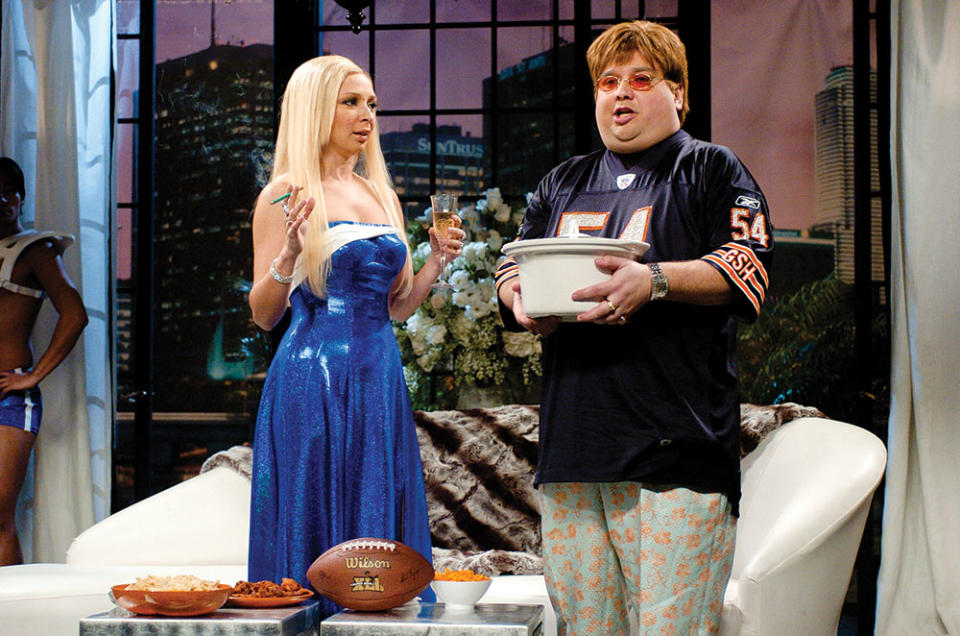
Dana Edelson / NBC / Courtesy Everett Collection
But life has a way of intervening. Rudolph had her first daughter, Pearl Minnie, in 2005; she stuck around for another two years, juggling the all-nighters at work with the all-nighters at home, before deciding it was time to move on. “It was really hard for me to lose her,” says Michaels, though it was considerably harder for Rudolph, who was leaving her dream job and many of her closest friends behind. Not that she’s been a stranger to the show — in fact, she remains SNL‘s resident Vice President Kamala Harris because, she says, “They know if they call, I’ll be there” — and she maintains a daily text chain with her SNL ladies, which former writer Paula Pell famously dubbed the “SNL Tang” (short for, yes, poontang).
“Maya is the sort of the ethereal earth mother in the group. If you need kid advice or a homeopathic suggestion, it’s her,” says Spivey. “But also, she and Paula are the clowns, the ones who are down to get real goofy, real quick. And Maya’s definitely the first person to put on a wig.” The group, which also includes Poehler, Tina Fey, Ana Gasteyer and Rachel Dratch, has established a tradition of getting together for 50th birthdays — or it did before the pandemic had the women resorting to Zoom parties and virtual talent shows with their children, the “tanglets.” A few years ago, they even made a Netflix comedy, Wine Country, inspired by those birthday getaways; it was mostly just an excuse to spend more time together, and they flirt with the idea of doing a second for the same reason. “That’s the dream,” says Rudolph, “and every once in a while, we’ll be like, ‘Maybe that’s the next one?'”
***
The thing about landing your dream job at 27 is that then it ends and you have to figure out what’s next. Rudolph didn’t have a plan, much less another dream. For a while, she figured she’d “go do movies,” as other castmembers had done before her — though it became clear that the leading lady roles, like the one she scored in the Sam Mendes dramedy Away We Go, would be harder to come by. “You have to remember, it was different to be mixed back in 2007 or 2008,” she says. “I love to play a game now where I look at billboards and commercials and count, like, ‘There’s a mixed family. There’s another.’ But it wasn’t like that then.”
In order to justify leaving her growing family at home, the job really had to be worth it, too. And even when she was almost certain it would be, she still couldn’t always say yes. Like the time Rudolph was approached to star in Killing Eve. Rudolph had devoured Fleabag, which was also from creator Phoebe Waller-Bridge, and would’ve jumped at the idea of fronting her follow-up under other circumstances. “But there was no way I was about to move to Europe for months. Like, how?” she asks. When Rudolph and her family were in London for one of Anderson’s films, she did get a chance to go out with Waller-Bridge and, she confirms, “Phoebe’s the fucking best.”
If there’s been any kind of guiding philosophy to Rudolph’s career choices over the past 15 years, it is to do the projects that enable her to have fun with collaborators she genuinely enjoys. Starring in the 2018 afterlife dramedy series Forever, for instance, was a way to keep working with Fred Armisen; and Loot, about a woman who’s forced to start over after her billionaire husband leaves her, was a way to reunite with Forever‘s creators, Alan Yang and Matt Hubbard. “Alan loves to joke that none of us are crazy, so we love working together, but it’s true and you get to a point in your life where you realize how important that is,” she says. “No one ever says it, but you’re truly meeting people in this business to make sure they’re not ax murderers and you go from there.”
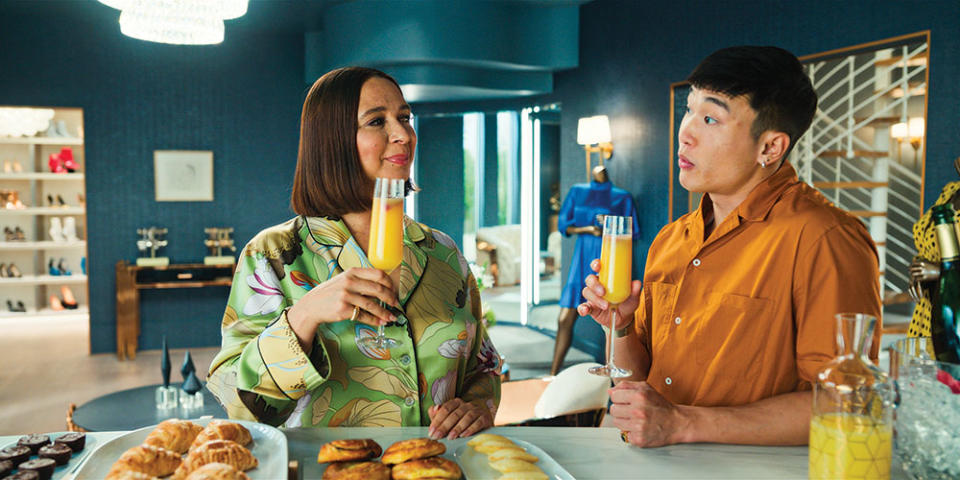
Yang and Hubbard had been watching Jeff Bezos’ marriage implode when they approached Rudolph with the idea for Loot. They weren’t interested in making it with anyone else. As Yang sees it, the facility with which Rudolph’s facial expressions alone communicate is peerless. “Whenever we’re in jeopardy in the edit, we’ll always just go, ‘Let’s go to a close-up on Maya, she’ll give us something,’ and she always delivers,” he says. And Hubbard’s in awe of how much she’s already done in her career, and without any whiff of ego. “There’s this scene in Loot where she’s acting with a llama, and I remember her going, ‘This is not my first llama,’ and, like, it wasn’t,” he says with a laugh.
Rudolph’s been known to pop up in Anderson’s films from time to time, too, beginning with Inherent Vice, which she shot four days after giving birth. “The timing was a little intense,” she acknowledges, “but I would do anything that Paul asked me to do.” His latest, Licorice Pizza, included not only Rudolph but also all four of their children and many of their friends. The decision was born out of necessity, she says, since they were shooting early in the pandemic and wanted to be sure they knew and trusted everybody on set. “So, it was just our universe for that period, and it saved us because we all got to be together. Plus, my kids got to watch their dad make a film, from the ground up, and we were all part of it. Pearl, my oldest, she really loved it — all the kids did.”
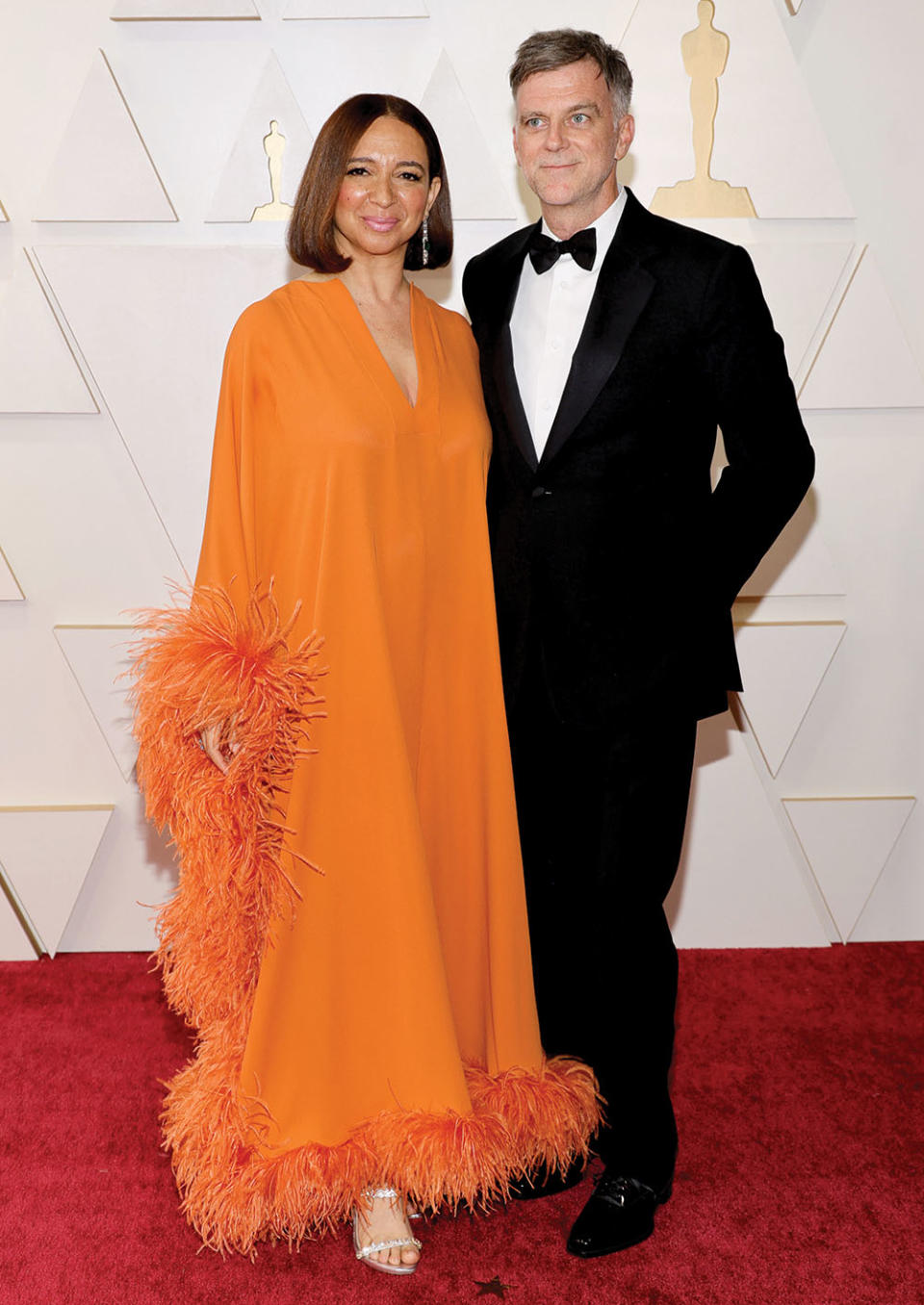
Mike Coppola/Getty Images
It’s too soon to know whether the Anderson children, who range in age from 8 to 16, will follow their parents into the entertainment business. Rudolph wouldn’t be surprised, nor is she discouraging of it. In fact, they’ve been making movies on their iPads for years, and since they, like her, are musically inclined, she’s been trying to get them to form a band. “We have enough people, but they won’t do it,” she says with a tinge of disappointment in her voice. At least a few of them have started watching SNL, however, just as she did as a kid, and she got to take them to the show when she hosted last year. To date, only her oldest has seen her other breakout, Bridesmaids. “She grew up with people coming up to me saying how much they loved it, and she was like, ‘Why can’t I see it?’ ” says Rudolph. “So I put it on and I realized, ‘Oh, they’re having sex at the beginning.’ Then we watched Lady Bird, and I was like, ‘Ehh, Bridesmaids is fine.’ “
As for the infamous scene in which her character, hit with an ill-timed bout of food poisoning, defecates in the street with her wedding gown on, all of Rudolph’s kids know about that. People have been referencing it in their presence for years. One time she went to Starbucks and, instead of her name on the cup, the barista wrote, “the lady that took a shit in the street.” She appreciated that a lot more than she did the Emmy she won for the animated comedy Big Mouth, which arrived with the episode’s title, “How to Have an Orgasm,” engraved on its base. “That bummed me out,” she says, because her children opened it and promptly asked, “What’s an orgasm?” Rudolph wasn’t exactly prepared to explain it to her then 7-year-old, so she did what any parent might do in that scenario and ignored the question entirely.
***
In late May, Rudolph decamped to New York to be by Lyonne’s side as she hosted the SNL season finale. She spent the week in a nearby hotel, coaching and calming her friend of 20-plus years. Then, on show night, Rudolph joined her onstage during her monologue and delivered a pitch-perfect impression of Lyonne’s gravelly New York accent.
Their friendship, which is now also a working relationship, dates back to the early aughts. Lyonne describes it as a kinship between two people whose “inner children feel very safe with each other.” She has plenty of “emo stories” about Rudolph making sure she believed in herself or got enough rest, even a few from her week at SNL, but those don’t make her laugh the way their early exploits together do. “Like the trip we took to Hawaii for no reason, which was like Hunter S. Thomson and Gilda Radner taking to the beach,” says Lyonne. “Like, I’m in some weird green visor and giant aviators, smoking a pipe in my bikini, I don’t know why, and Maya’s this lanky little ’70s creature with that little hairdo, all smiley and full of life, trying to figure out how to play tennis in the heat.”
For Rudolph, being back in Studio 8H was a meaningful reminder of just how happy she is onstage. A second one came a few weeks later, when her Prince cover band, Princess, performed at the Netflix Is a Joke festival in L.A. Singing used to be on the list of things that terrified Rudolph; like stand-up, it required her to be herself and not some wigged, wacky character at the mic. But she’s grown increasingly comfortable following in her mother’s footsteps; of course, her version of a music career has her singing covers, which, in some ways, is a cover itself.
At this point, Rudolph’s not particularly fussed about whatever comes next. She has four healthy children and a career she never could have dreamed of. She’s certainly enjoying all the voice work she does. For years, she would have said a Broadway musical was still high on her bucket list, but she’s not so sure she has the stamina for that anymore. Singing and dancing in a corset for 10 hours a day, which is what the upcoming Disney musical Disenchanted demanded of her, left the star “physically wrecked” — and Broadway would require eight shows a week. “Maybe one day …” she says, trailing off.
For now, Rudolph’s focused on finding opportunities to perform live where she can, making us laugh, hiding in plain sight behind her divas. “I think the armor has done me some good because I don’t want to be a person who has nothing left for myself,” she says. “I enjoy the armor.”
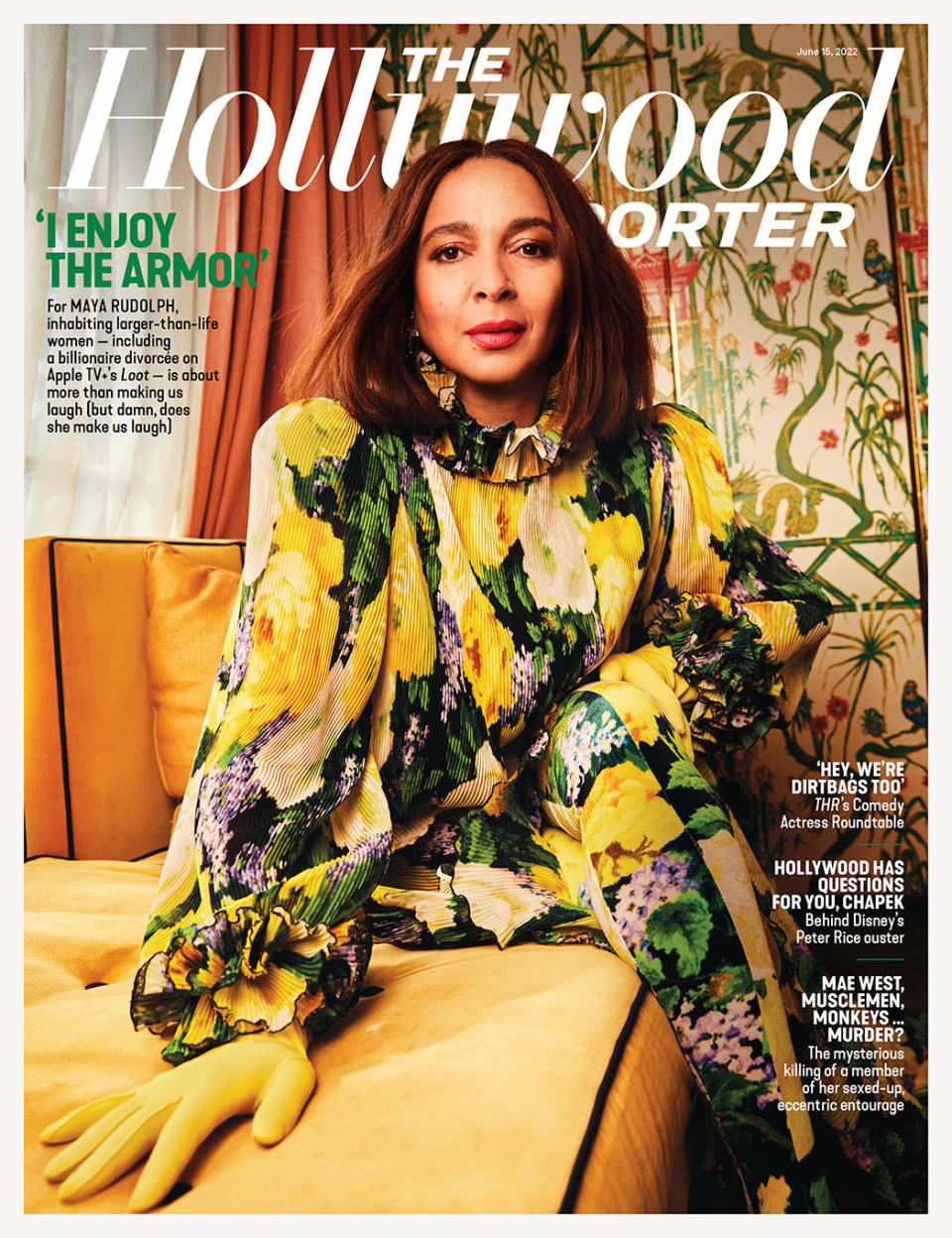
This story first appeared in the June 15 issue of The Hollywood Reporter magazine. Click here to subscribe.
Best of The Hollywood Reporter

